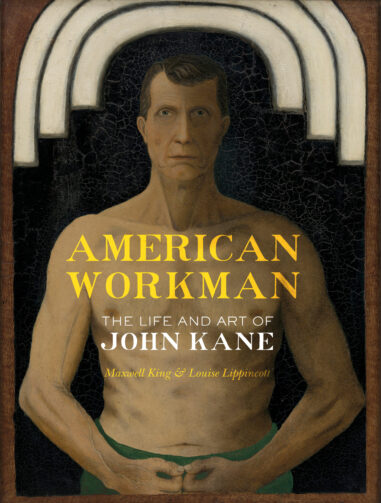American Workman
The Life and Art of John Kane
An exhaustive biography as well as a deep critical appreciation of Kane’s art, American Workman should bring new attention to this artist’s remarkable work.
Request Exam or Desk Copy. Request Review Copy
American Workman presents a comprehensive, novel reassessment of the life and work of one of America’s most influential self-taught artists, John Kane. With a full account of Kane’s life as a working man, including his time as a steelworker, coal miner, street paver, and commercial painter in and around Pittsburgh in the early twentieth century, the authors explore how these occupations shaped his development as an artist and his breakthrough success in the modern art world. A rough-and-tumble blue-collar man prone to brawling and drinking, Kane also sought out beauty in the industrial world he inhabited. This Kane paradox—brawny and tough, sensitive and creative—was at the heart of much of the public’s interest in Kane as a person. The allure of the Kane saga was heightened all the more by the fact that he did not achieve renown until he was at the age at which most people are retiring from their professions. Kane’s dedication to painting resulted in a fascinating body of work that has ended up in some of America’s most important museums and private collections. His dramatic life story demonstrates the courage, strength, and creativity of his generation of workmen. They may be long gone, but thanks to Kane they cannot be forgotten.
More Praise
American Workman revisits the life and works of John Kane, a significant figure in the intersecting histories of self-taught art and American modernism. King and Lippincott offer a thorough, accessible account of the artist from his Scottish childhood through his years working as a laborer in Pittsburgh, PA, to his reception as an artist celebrated on a national stage. The work offers first a chronicle of Kane's life and then segues into a discussion of his art and its reception. Commitment to a generous exploration of Kane's life and times unites the authors' narratives, enabling readers to grasp the extraordinary arc of Kane's career. . . .The authors' primary goal for American Workman is the recuperation of Kane's legacy for future histories of American art, and they succeed in a historical moment when the larger impacts of a diverse array of self-taught artists—William Edmondson, Grandma Moses, Morris Hirshfield, Bill Traylor—are being reassessed. Highly recommended.
American Workman asserts that everything we thought we knew about Kane is probably wrong.
American Workman, the first new account of Kane’s life and work in fity years, is gorgeous . . . King presents a thoughtful account that shuns the contemporary tactic of inventing scenes and dialogue . . . [and] Lippincott also offers bracing art-historical detective work and well-grounded speculation about Kane’s motives and aims.
Lippincott should be applauded for the deep research in her half of the book, which focuses exclusively on Kane’s art. . . . While Kane’s work may still be a fixture at MoMA, maybe it’s time he’s broken out of that stuffy Masters of Popular Painting gallery. American Workman may provide the groundwork for doing just that.
This reassessment of the life and art of John Kane (1860-1934) sets a new standard for art scholarship. . . . Illustrations make this book a rich experience.
When Andy Warhol first hit the art world, he was only the second most famous painter to come out of Pittsburgh. John Kane, steelworker and house painter, had garnered his own headlines in the 1920s, when museums discovered his ‘primitive’ oils. Almost a century later, Maxwell King and Louise Lippincott are giving Kane the attention he deserves. They do a lovely job on both life and art, and the amalgam Kane forged from the two.
John Kane saw beauty where others saw a tortured industrial landscape. His artistic eye saw the can-do spirit of Pittsburgh, often filtering out the gritty ugliness that other observers could not see through. Maxwell King and Louise Lippincott have achieved something quite remarkable with their insightful and balanced examination of a most extraordinary man whose talent enabled him to elevate fleeting moments of ordinary life to works of art for the ages.
American Workman is a long-overdue reexamination of the first self-taught American painter to be taken up by the modern art establishment. As Louise Lippincott notes, there are many parallels between our twenty-first century reality and Kane’s Depression-era Pittsburgh—among them, a glaring divide between economic haves and have-nots, and an art world hungry for the next big thing. . . . This is not, however, a rags-to-riches story, but something more trenchant. Although John Kane died in poverty, he left an artistic legacy that both spoke to his time and transcended it.
American Workman is a fascinating look at not only the life of a troubled working-class artist but also the surrounding Gilded Age world of industrial might—and the plight of laborers from 1880 through the Great Depression. The story of John Kane illustrates many facets of history, particularly for students of labor, art history, sociology, and Pennsylvania. King and Lippincott called this book a ‘visual exercise,’ one that attempted to convey a ‘faithful portrait of Kane’s time and place,’ and to that end, the authors most certainly succeeded. . . .[American Workman] was a terrific blend of narrative and images, which more than successfully portrayed the life and world of one of Pennsylvania’s most overlooked artists.
308 Pages, 7 x 9 in.
April, 2022
isbn : 9780822947042
Subjects
- Art / American / General
- Art / Folk & Outsider Art
- Art / General
- Art / History / Modern (late 19th Century to 1945)
- Art / Individual Artists / General
- Art / Individual Artists / Monographs
- Art / Subjects & Themes / General
- Art / Subjects & Themes / Religious
- Art / Techniques / Oil Painting
- Biography & Autobiography / Artists, Architects,
about the authors

Maxwell King is the former editor of the Philadelphia Inquirer and president of the Heinz Endowments. He is the author of the poetry collection Crossing Laurel Run and the New York Times-bestselling Mister Rogers biography The Good Neighbor: The Life and Work of Fred Rogers. King also served as chairman of the board of the national Council on Foundations. His most recent job was president of The Pittsburgh Foundation.
learn more

Louise Lippincott is a historian and former curator specializing in American and European art from the Enlightenment to the modern era. She focuses on artists outside the mainstream, and the historical contexts that give meaning to their work. As curator of fine arts at Carnegie Museum of Art, she managed the largest John Kane collection in the United States. Previously she occupied curatorial positions at the J. Paul Getty Museum and Philadelphia Museum of Art.
learn more

